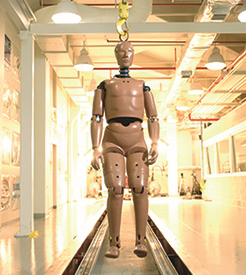Document Type
Conference Proceeding
Publication Date
9-30-2002
Publication Title
46th Annual Proceedings Association for the Advancement of Automotive Medicine
Abstract
Recent laboratory investigations suggest that a deploying airbag may fracture the forearm. These studies positioned the arm in an overhand grasp placing the forearm over the airbag module. However, there is little published data on how drivers grip the steering wheel and the general proximity of the upper extremity to the airbag module. The objective of the current study was to identify 'real world' upper extremity positions and to correlate these with accident and experimental data. A survey of the National Automotive Sampling System (NASS) for the years 1995-99 revealed an increase in the number of forearm fractures due to driver-airbag interaction. As NASS does not provide the position of the forearm, common upper extremity positions were identified in a volunteer driving population. These positions were simulated using a specially instrumented 50th percentile male dummy to determine the relative injury risk for the different positions. Analysis showed that an under hand grasp of the wheel turned 90° yielded the highest magnitude impact event. This single position was then simulated in 9 cadaver experiments. Dual stage airbag deployments produced forearm fractures in 2 arms. Experiments using the contralateral arms from the fractured subjects with a single stage airbag deployment produced no fractures. Analysis of forearm kinematics suggests that increasing forearm velocity and thus, acceleration exposure, is associated with forearm injury. Further, the data suggests that reductions in acceleration exposure via reduced airbag inflation decreased the apparent risk of forearm fracture.
Volume
46
First Page
1
Last Page
18
ISSN
0892-6484
Rights
© 2002 Association for the Advancement of Automotive Medicine (AAAM). Posted with permission.
Recommended Citation
Atkinson, Patrick J.; Hariharan, Prem; Mari-Gowda, Shresta; Telehowski, Paul; Martin, Sidney; Hoof, Jack Van; Bir, Cynthia; and Atkinson, Theresa, "An under-hand steering wheel grasp produces significant risk to the upper extremity during airbag deployment" (2002). Crash Safety Center Publications. 35.
https://digitalcommons.kettering.edu/crash_pubs/35



Comments
Tempe, AZ